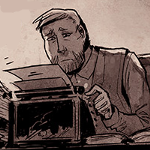Information Technology (IT) refers to the technologies used to store, transmit and receive, and manipulate information. Pre-Rash, the term had become commonplace only in the context of computer networks exchanging digital data, though it also covered preexisting technology like television and telephone networks.
Storage[]

Aside from people's memories (which, for example, the Finnish system of training mages seems to be focused on), the main means of preserving information post-Rash are written records. Seeing that timber is one of the main resources, one would expect paper to be relatively plentiful, but sheets shown in the comic are occasionally downright transparent.
We have no information yet what kinds of ink are available and used. Mechanical typewriters seem to be popular writing implements for official paperwork, though the one we've seen close up had a QWERTZ layout suggesting a central European provenance. A fountain pen complete with inkwell was shown next to it. It seems unlikely that the post-Rash economy would produce ballpoint pens, as the balls require precision machining.
It is also yet unknown which of the other pre-Rash information storage technologies can still be read in year 90 (and, if so, by whom). Early in chapter eight, Mikkel throws out the DVDs that Sigrun and Emil collected at The Fictional School as "garbage", but this might be prompted by the fact that even in perfect storage conditions, CDs and DVDs turn unreadable over a timespan of ninety years.
On arc 1 page 180![]() , Emil claims to have listened to a recording of spoken Danish. No details on that technology have been presented, though.
, Emil claims to have listened to a recording of spoken Danish. No details on that technology have been presented, though.
Transmission[]

While electronic devices are said to be rare and expensive, instances of information transmission technology seem to be surprisingly plentiful. Radio - more precisely, voice transmission - in particular is applied for purposes from walkie-talkies to city-scale public broadcasting to long-distance communication. The city of Mora is said to also possess a telephone network, and the Dalahästen communicated its damages to the Öresundsbro base ahead of its arrival.
There do not seem to be any means of long-distance communication using wires (or, for that matter, optical fiber). This is particularly interesting because long-distance radio communication suffers from grossling interference that needs intervention by a mage to be suppressed, while electric power in whole or in part is provided to settlements from few central power plants, presumably by power lines.
In any case, larger amounts of data, like personnel files, are routinely exchanged by messenger.
Processing[]
While there seem to be electric displays and, rarely, refurbished devices with screens, there was no clear indication of machine-based data processing so far. The fandom believes that Iceland, with its relative stability through the apocalypse, might have been barely able to keep a handful of computers in an operational state, maybe at Reykjavíks universities, two of which had Computer Science departments in year 0. However, it must be noted that microchips could not stay operational for 90+ years, due to diffusion happening between metals and silicone base. Any computer that might exist in the Known World thus would probably be a vacuum-tube post-Rash design.
Bornholm, as the other large area that was a major settled area before and throughout the pandemic, had no particular industries or academies that would promise that computers have remained available.
